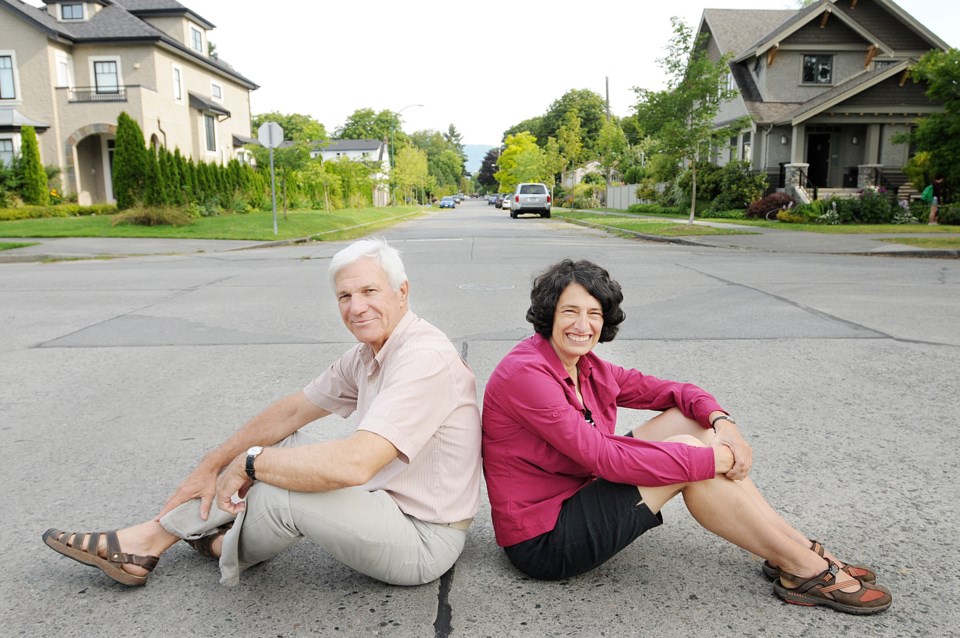It was only a year ago this week that council approved a motion to look into the possibility of creating a thin street in one of the neighbourhoods updating a community plan — Marpole, Grandview-Woodland or the West End.
The idea of thin streets, which involves dividing a street in half and creating new building lots on one side and a narrower “thin street” on the other so building lots could be used for affordable housing or park use, came out of the re-THINK HOUSING ideas competition in 2012, which was held as part of the mayor’s task force on affordable housing.
The idea, however, died a quick death in June after a thin street was pitched for Marpole. City staff proposed, in the draft Marpole Community Plan, to turn a stretch of Ash Street between 59th and 64th into a thin street.
Faced with opposition from residents, the city almost immediately abandoned the idea, but Ted Sebastian and Christina DeMarco insist it’s still a concept worth examining.
The former planners, along with Charles Dobson, submitted the idea to the re-THINK HOUSING competition. The Courier caught up with the pair earlier this week. Both hope the initiative is somehow resurrected.
“I think it would be unfortunate if they chopped it on the basis of what happened in Marpole,” Sebastian said. “If there’s interest, you need to think carefully about a process that would have some possibility of a positive outcome, but we’d very much like to see it happen.”
Sebastian was encouraged when the scheme was initially embraced, but conceded it’s a “very sensitive topic that required a significant amount of resources to discuss with the communities in a way that might encourage them to move forward with it.”
He wasn’t surprised by the pushback in Marpole.
“It’s very difficult because unless people gain a full understanding of the benefits and there’s a process that is comprehensive enough to get people to look beyond the immediate reaction of saying, ‘Oh my God, I own a corner property and I’m going to have a house next to me,’ then you’ll always get the same response. From our perspective it’s a question of resourcing a process.”
Both DeMarco and Sebastian agree such a discussion should happen as part of a community plan.
“Because then you could have the full dialogue — you’re talking about streets as a community resource and that there’s an overabundance of streets, so when the community’s thinking about its future, what is it they need more than these streets,” DeMarco said. “The whole idea of using the value of that land to either do affordable housing or community centres or little parks, so it would be very good to have that dialogue with the community on what [they] lack, how can this meet [their] needs, as well as meeting the needs of people who want to age in place and have smaller houses.”
Sebastian said a way to overcome objections from owners of corner properties is for the city to buy the lot when it comes up on the open market.
“Buy it and create the new lot and resell the former corner lot as an interior lot and the city wouldn’t lose any money in the process and you wouldn’t have people thinking they were having a huge change right next door to them.”
DeMarco sees thin streets as an option in communities that oppose forms of densification such as towers, as was the case recently in Grandview-Woodland.
“If people accepted that they do want gentle change in their neighbourhood to keep the schools open, to have a variety in housing, what form do they want it in? Thin streets was, in our mind, a form of gentle densification without having the long shadows of towers and the disruption of the neighbourhood through towers,” she said.
“We definitely wouldn’t do it without having the neighbours onside… [but] I think it’s too good an idea to die on the vine. I think it’ll come back somehow, but it has to be done very, very gently.”
When the Courier spoke to Brian Jackson, the city’s manager of planning and development, earlier in the summer he said the idea is dead for the community plans underway, but said the future is uncertain.
“You never say never, but on the other hand, if we do introduce it, we have to do it earlier in the process so that people understand what it’s about and we’re specific about its location as opposed to later on in the process.”



